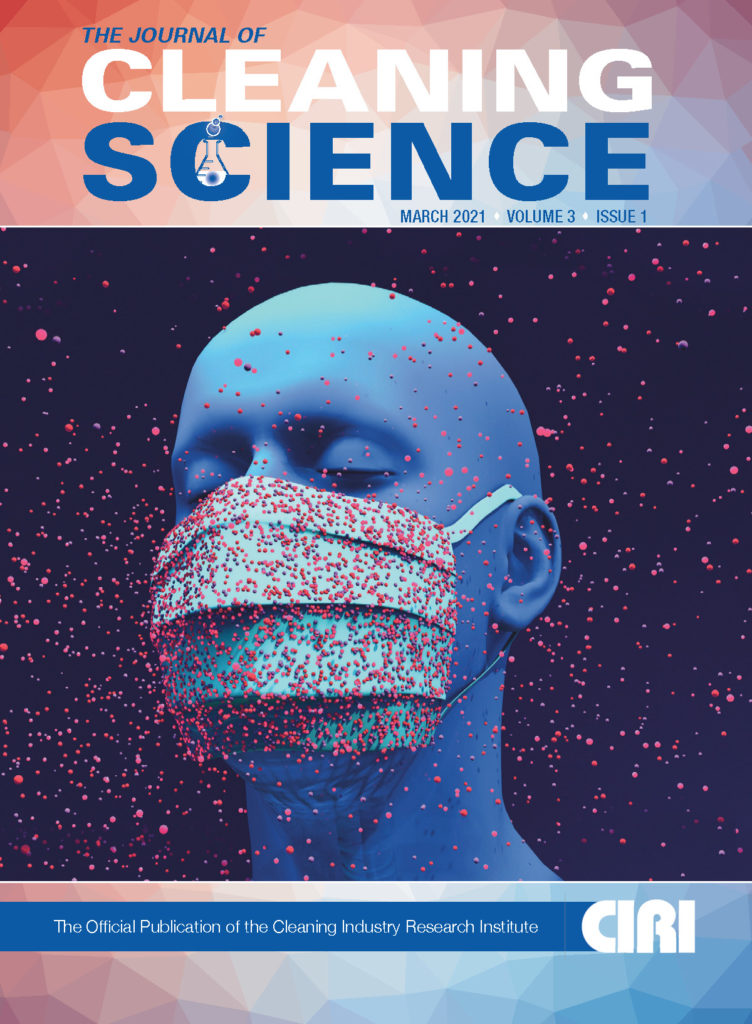
Article Information
Dr. Ralph Moon is a Principal Scientist with NV5, Inc. in Tampa, FL. He is a graduate of Western Michigan University (BA Biology) and the University of South Florida (MA Botany, Ph.D. Biology). Dr. Moon was employed as a lock-out diver at the Harbor Branch Marine Lab in Fort Pierce, FL, an industrial hygienist at the Jim Walter Research Corporation, groundwater consultant with Geraghty and Miller Engineers and Consultants, and HSA Engineers and Scientists in Tampa, FL. Dr. Moon’s research interests in moisture exposure studies on wood and metal building materials began in 2004. His peer-reviewed papers are diverse and range from cleaning methods for mold-contaminated fabrics to raccoon scat remediation.
3/1/2021.
The Journal of Cleaning Science March 2021.
ATP surface testing is an effective method to evaluate cleanliness under the right circumstances. This paper examines the variables that influence ATP measurements and refines our understanding of this forensic tool so that ATP test results can be used purposefully and confidently.
The article is about ATP technology applied to restoration. The first topic for discussion concerns interference by disinfectants. Moon states: Whether used in hospital disinfection or a home restoration effort, the three most common ingredients are hydrogen peroxide, bleach, and alcohol. Moon then references studies that show that hydrogen peroxide and bleach interfere with the luciferase reaction. Therefore, he concludes that ATP cleanliness testing may have little application in real world situations. However, while bleach-based products are often used to clean and disinfect floors and furniture in hospitals not so in homes because home floors and furnishings are usually much more sensitive to bleach damage than hospital settings. Moon is equating hospital rooms to residences, in so doing he is perhaps being too tough on the use of ATP technology for post remediation testing in homes. DDRS is open for discussion on this topic.
The second topic for discussion concerns the importance of ATP testing as a measure of bacteria growth phases. Moon concludes after reviewing several recent articles that since ATP technology cannot identify the growth phase of bacteria, therefore ATP testing may offer an erroneous perspective on cleanliness. But is that what restoration contractors use or should use ATP testing for … identifying the growth phase of bacteria? Or for post remediation cleanliness testing to determine how well the surface has been cleaned of total contaminants? Likely the restoration contractor is only interested in post remediation cleanliness testing of total contaminants therefore again Moon is a little tough on the application of ATP testing for restoration. DDRS is open for discussion on this topic. IICRC S520-2015 includes ATP testing as a recommended procedure for post mold remediation evaluation. Is their anything in Moon’s review that would challenge that recommendation?
Rating Breakdown
Why 4.5 Star? Discusses / reviews ATP testing for the restoration industry. An excellent introduction.
1-5 Stars System
- Positive: Greater than or equal to 4 (4.0 – 5.0) MUST READ
- Neutral: Greater than or equal to 3 but less than 4 (3.0 – 3.9)
- Negative: Less than 3 (2.9 – 0)
Search Tags Below

Discussion question #1. Moon is equating hospital rooms to residences, in so doing he is perhaps being too tough on the use of ATP technology for post remediation testing in homes. DDRS is open for discussion on this topic.
Mold remediators do not commonly use cleaning agents for content and floors that include oxidizers such as bleach or hydrogen peroxide due to concerns about damaging fragile household materials/flooring. This application is very different from hospital rooms that
are built to be cleaned with popular/strong bleach-based or popular/strong peroxide-based
cleaners to disinfect and remove dangerous blood borne pathogens and microbial
contaminated fecal matter.
Water damage restoration contractors and mold remediators on the other hand rely mostly on Quat based cleaners/ disinfectants or plant based disinfectants. Bleach (as used in hospitals) of course does interfere with the ATP readings since the bleach denatures/ destroys the firefly luciferase enzyme. Quat based or plant based (such as Thymol) disinfectants used in homes do not.
There is no reason to not use ATP meters for testing cleanliness in residential or office use due to concerns about residual bleach/peroxide.
The second topic for discussion
concerns the importance of ATP testing as a measure of bacteria growth phases.
Water damage restoration contractors and mold remediators are not in any way concerned about measuring bacteria growth phases. We are not sure why Moon is concerned.
Water damage restoration contractors and mold remediators simply want another means to supplement post remediation cleanliness testing based on visual methods (for example white gloves testing/Swiffers™). In particular, restoration/remediation contractors desire something that is more “scientific” than visual. And something that involves testing that can be charged for.
IICRC S520-2015 includes ATP testing as a recommended procedure for post mold remediation evaluation. This makes sense and ATP is also useful for post remediation testing of classrooms and office buildings after cleaning by Janitorial services for the same reasons. And it is used and widely studied and is considered successful in the food industry. As far as use in hospitals or other critical care facilities see one of Moon’s reference articles here.
They conclude regarding ATP technology in healthcare use: “Our findings suggest that introducing ATP meters to healthcare facilities, as a disinfection validation tool is not a reliable choice.”
Here we discuss an aspect of Moon’s reference to Omidbakhsh et al. The Omidbakhsh article is attached at the end of Moon’s paper.
One of the problems with peer-review is that reviewers often do not carefully read all the
references. So here is a mistake that reviewers missed in Moon’s interpretation
of the Omidbakhsh article. We point this out not to be overly critical, but we mention because this issue deserves more discussion.
On page 13 of Moon’s article, we have highlighted a sentence in blue type: “however, all
test meters showed similar variations from the control concentrations in response to the presence of disinfections”. This is not correct.
The Omidbakhsh paper on page 5 says “The 3M-meter is also shown to be the most susceptible to disinfectant chemistries.” There is huge differences in susceptibility of the ATP luminometers to cleaning/disinfecting chemicals “according to” Omidbakhsh experiments.
According to Omidbakhsh et al, since hospitals use many of the disinfectants that interfere with luminometers, especially 3M … Omidbakhsh et al conclude page 7: … introducing ATP meters to healthcare facilities, as a disinfection validation tool is not a reliable choice.
1.) For our restoration readers that are not using ATP testing in hospital setting, this conclusion is of no value. The disinfectants used by restoration and remediation contractors are not the same as used by hospitals. So the conclusion is not applicable to the DDRS readers.
2.) The article uses the word “disinfection”. However, ATP testing does not in any way measure “disinfection” (killing). It only measure cleaning (removal.) Any researcher (Omidbakhsh et al) that does not know the difference is suspect.
3.) The method that Omidbakhsh et al use to determine what affect the chemicals have on ATP testing is to pour the chemical directly into the ATP lysing agent. That technique makes no sense. When someone swabs a dry floor there will never by any residual bleach or peroxide that will interfere with the firefly luciferase enzyme. Why, because once dried they are no longer active (unlike the situation with non-oxidizing chemicals such as quats.) The lab study is not in any way representative of the real world.
Moon’s article concerns the “Restoration Industry”. That’s in the title. Yes there is a dearth of research on ATP in the restoration industry and it is mostly or all from the health care industry. Caution should be taken regarding drawing conclusions about the benefit, use or misuse of ATP testing for restoration based on studies in the health care industry.
As editor of the Journal of Cleaning Science (JCS) I worked with Dr. Moon in development of this paper. It went through multiple peer reviews before being green-lighted for publication.
Although ATP has been studied extensively for cleaning, in particular in schools and healthcare environments, there is scant research on its use in restoration and remediation (r&r) environments. But the dearth of research has not resulted in restraint in restoration settings. Dr. Moon’s paper set out to explore the research and to the extent possible apply it to the processes used and environments encountered in restoration. The result is a paper that acknowledges the usefulness of ATP in general but urges caution when utilizing it in many r&r situations.
I see this paper as a useful first step, but by no means the last word on ATP use in r&r. I believe Dr. Moon would agree with that.